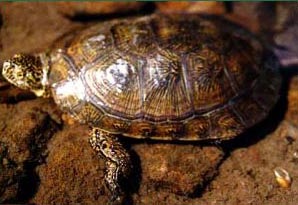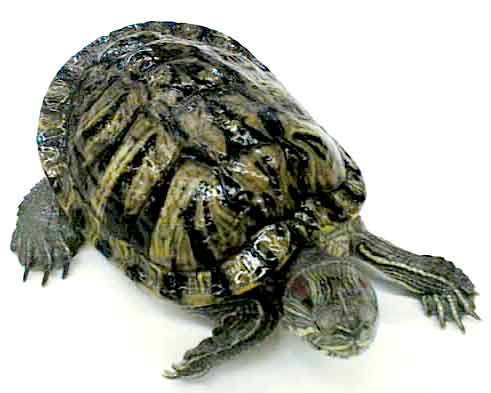Western Pond Turtle

Source: http://www.tortoise.org/gallery/picpac.html
Western Pond Turtle

Source: http://www.tortoise.org/gallery/picpac.html
Redeared Slider Turtle

Source:http://www.lawrencehallofscience.org/Biolab/
meetreptiles/redearedslider.html
Turtles
The data collected in this study will give the City of Eugene a baseline from which to gauge the success of their restoration efforts. It will be informative to gain an idea of the number of western pond turtles that utilize the habitat of the ponds, and to compare this information with studies done at other locations. This will give us insight into whether or not turtles have reached the carrying capacity of the ponds, and identify which factors, if any, are preventing them from reaching their potential for population growth. One key species and one species of interest are listed for our turtle survey.
Western pond turtle (Clemmys marmorata)
Why is the Western pond turtle a key species?
Some estimates claim that the western pond turtle has seen a decline of 96% in the Willamette Valley, to a current population of some 1500 individuals. Some of these remaining individuals occupy the Delta Ponds. The western pond turtle is listed as a federal species of concern and a sensitive species in Oregon, and is one of only two turtle species indigenous to Oregon.
What does a Western pond turtle look like?
The western pond turtle grows to be around 200 millimeters in length, and has a dark brown coloration on the top, or carapace, of its shell. The chest plate, or plastron, is yellow in color. Males tend to be lighter in color, have a flatter shell, and have a concave plastron.
What are the threats to the Western pond turtle at Delta Ponds?
Numerous invasive species pose a threat to the western pond turtle at the Delta Ponds bullfrogs and bass prey on Western pond turtles and Himalayan blackberries obstruct nesting sites. Human activity also threatens these turtles habitat through pollution, noise, and physical barriers.
What are the monitoring methods used to find Western pond turtles at Delta Ponds?
We will set up a monitoring plan using several traps at key locations around the ponds. These aquatic traps are baited with dead fish, and checked daily for three weeks in the spring. The weight, length, and sex of each turtle will be recorded, and each turtle will be given a white mark on its back for future identification. At the end of the trapping period, a visual survey will be conducted, using the shell markers, to determine the ratio of turtles that were caught in the traps.
What are the results of trapping Western pond turtles at Delta Ponds?
This data is not in yet. Stay tuned at see our Events page if you are interested in volunteering to help with turtle surveys!
Red-eared slider (Trachemys scripta elegans)
Why is the red-eared slider a species of interest?
The red-eared slider is an invasive aquatic turtle species that is common at the Delta Ponds. Their presence at the ponds is important because they compete with the western pond turtle for food and basking sites. Disease transmission can also occurs between red-eared sliders and western pond turtles, and has been known to devastate native turtle populations
What does a red-eared slider look like?
They can grow to be a foot long and are characterized by yellow markings on their shell and bright red horizontal stripes behind each eye.
For more information on the turtles at Delta Ponds see:
Holland, Dan C. The western pond turtle : habitat and history : final report / prepared by Dan C. Holland ; prepared for U.S. Department of Energy, Bonneville Power Administration, Environment, Fish, and Wildlife. Portland, OR (P.O. Box 3621, Portland 97208-3621): The Administration, [1994]
Introduced Species Summary Project: Red Eared Slider (Trachemys scripta elegans). Mara Pendergrass. December 9 2002. http://www.columbia.edu/itc/cerc/danoff-burg/invasion_bio/inv_spp_summ/Red-eared%20Slider%20Turtle.html
Lovich, Jeff; Meyer, Kathie. The western pond turtle ( Clemmys marmorata ) in the Mojave River, California, USA: highly adapted survivor or tenuous relict? Journal of Zoology. Vol. 256, number 4, 537-545 (2002).
Todd, Laura L. (Laura Lynn) The ecology and habitat use of the northwestern pond turtle (Clemmys marmorata marmorata) in a lake in southwestern Oregon [microform] / [Portland, Or.] : Portland State University ; [Washington, D.C. : U.S. Fish and Wildlife Service, 1998]
